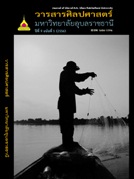ขบวนการเคลื่อนไหวต่อต้านเหมืองแร่ทองคำ
Main Article Content
บทคัดย่อ
Social Movement against Gold Mining
The research has adopted the collective action framing tasks proposed by Snow and Benford to study the framing process. These include diagnostic framing, prognostic framing and motivational framing. Regarding diagnostic framing, “injustice frames” was identified which confirmed previous studies. In addition, this research was able to identify two other important diagnostic framing shared by the two cases under study, one being the state’s development policy biased towards industrial development and against agricultural development and rural people’s way of life and the other, the alliance between the state and the private sector. Based on these three diagnostic frames, two levels of corresponding prognostic framing were made. The movement demanded that the state make structural reform through the amendment of the mining law and change unfair mining concession terms. At the local level, movement representatives stood for local government elections with the aims to make local structural reforms, tackle monopoly problems and change local development policies. As for motivational framing, the vocabularies used to mobilize movement participation were “disastrous mining” and “dangerous impact” to warn against the severity and urgency of the problems, while putting forward the “community culture” discourse as a mobilizing tool.


